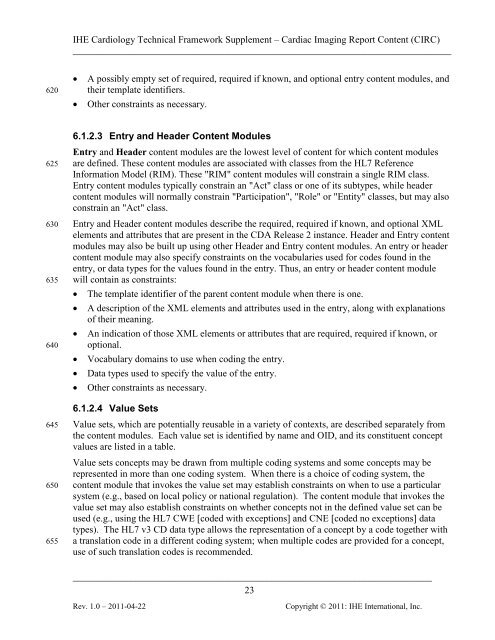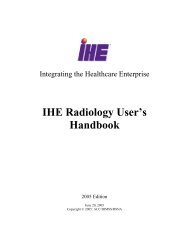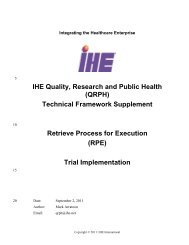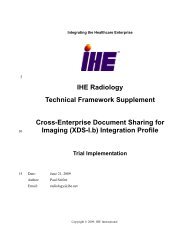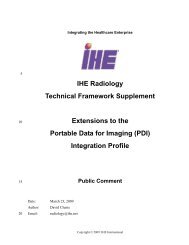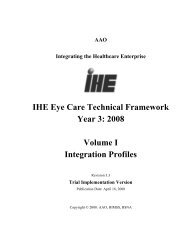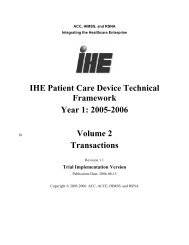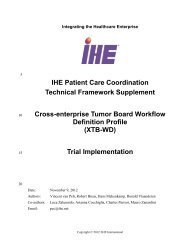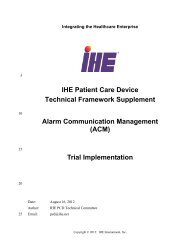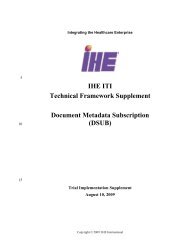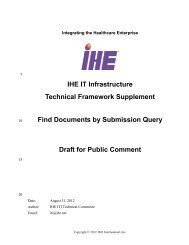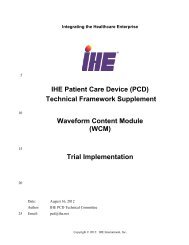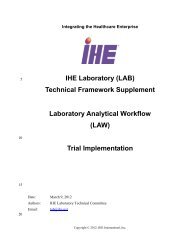IHE Cardiology Technical Framework Supplement Cardiac Imaging ...
IHE Cardiology Technical Framework Supplement Cardiac Imaging ...
IHE Cardiology Technical Framework Supplement Cardiac Imaging ...
- No tags were found...
You also want an ePaper? Increase the reach of your titles
YUMPU automatically turns print PDFs into web optimized ePapers that Google loves.
<strong>IHE</strong> <strong>Cardiology</strong> <strong>Technical</strong> <strong>Framework</strong> <strong>Supplement</strong> – <strong>Cardiac</strong> <strong>Imaging</strong> Report Content (CIRC)______________________________________________________________________________620• A possibly empty set of required, required if known, and optional entry content modules, andtheir template identifiers.• Other constraints as necessary.6256306356406456506556.1.2.3 Entry and Header Content ModulesEntry and Header content modules are the lowest level of content for which content modulesare defined. These content modules are associated with classes from the HL7 ReferenceInformation Model (RIM). These "RIM" content modules will constrain a single RIM class.Entry content modules typically constrain an "Act" class or one of its subtypes, while headercontent modules will normally constrain "Participation", "Role" or "Entity" classes, but may alsoconstrain an "Act" class.Entry and Header content modules describe the required, required if known, and optional XMLelements and attributes that are present in the CDA Release 2 instance. Header and Entry contentmodules may also be built up using other Header and Entry content modules. An entry or headercontent module may also specify constraints on the vocabularies used for codes found in theentry, or data types for the values found in the entry. Thus, an entry or header content modulewill contain as constraints:• The template identifier of the parent content module when there is one.• A description of the XML elements and attributes used in the entry, along with explanationsof their meaning.• An indication of those XML elements or attributes that are required, required if known, oroptional.• Vocabulary domains to use when coding the entry.• Data types used to specify the value of the entry.• Other constraints as necessary.6.1.2.4 Value SetsValue sets, which are potentially reusable in a variety of contexts, are described separately fromthe content modules. Each value set is identified by name and OID, and its constituent conceptvalues are listed in a table.Value sets concepts may be drawn from multiple coding systems and some concepts may berepresented in more than one coding system. When there is a choice of coding system, thecontent module that invokes the value set may establish constraints on when to use a particularsystem (e.g., based on local policy or national regulation). The content module that invokes thevalue set may also establish constraints on whether concepts not in the defined value set can beused (e.g., using the HL7 CWE [coded with exceptions] and CNE [coded no exceptions] datatypes). The HL7 v3 CD data type allows the representation of a concept by a code together witha translation code in a different coding system; when multiple codes are provided for a concept,use of such translation codes is recommended.__________________________________________________________________________23Rev. 1.0 – 2011-04-22Copyright © 2011: <strong>IHE</strong> International, Inc.


